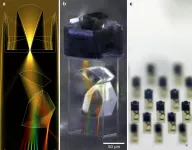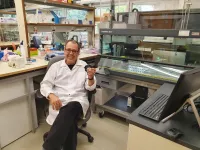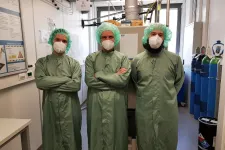INFORMATION:
Insights into lithium metal battery failure open doors to doubling battery life
2021-02-08
(Press-News.org) Lithium metal batteries could double the amount of energy held by lithium-ion batteries, if only their anodes didn't break down into small pieces when they were used.
Now, researchers led by Prof. CUI Guanglei from the Qingdao Institute of Bioenergy and Bioprocess Technology (QIBEBT) of the Chinese Academy of Sciences (CAS) have identified what causes lithium metal batteries (LMBs) to "self-destruct" and proposed a way to prevent it. The findings were published in Angewandte Chemie on Jan. 19.
This offers hope of radically enhancing the energy held in batteries without any increase in their size, and at reduced cost.
In fact, LMBs were the original concept for long-lasting batteries, but their anodes break down into small pieces - a microstructure known as "pulverization". The LMBs thus quickly stop working when being cycled through. Lithium-ion batteries were actually a compromise: tweaking the LMB concept prevented the anode failure by using graphite anode, but at a cost of much lower energy storage levels.
One of the problems facing LMB development has been a lack of understanding, and even controversy over, why the anode fails. Conventionally, it is argued that tiny tree-branchlike structures of lithium called dendrites form during cycling of the battery. In addition, the pulverization structure always appears in any failed LMB.
What has been contentious though is whether lithium hydride (LiH) is present in the pulverization structure. LiH has poor electrical conductivity, but it is also very brittle, which would explain the pulverization. In the past, one group of researchers had identified LiH as a distinct type of dendrite, but another group found nothing along these lines.
However, both research groups had only used simplified versions of an LMB. To properly investigate what is going on, the QIBEBT research team ran a practical LMB under typical operating conditions.
Using a type of mass spectrometry (an analytical tool that allows identification of unknown compounds), the researchers were able to confirm that LiH did indeed become the dominant compound on the anode as the battery was being used.
But more importantly, they found that this chemical reaction is temperature sensitive: it only happens at room temperature, and the process can be reversed if the temperature rises above this level.
This suggests ways that the production of LiH can be prevented, either via heat treatment or a pressure treatment producing the same effect, or a combination of the two. Additional options include suppressing the production of hydrogen ions, or the placement of interface materials that can protect the lithium from the hydrogen.
"Coming out of this study, the next step is to produce some form of really good lithium protection," said CUI Guanglei, lead author and a scientist with QIBEBT, "which should then deliver on the long-held promise of practical applications of the 'holy grail' of lithium metal batteries."
ELSE PRESS RELEASES FROM THIS DATE:
Researchers produce tiny nanoparticles and reveal their inner structure for the first time
2021-02-08
Tiny nanoparticles can be furnished with dyes and could be used for new imaging techniques, as chemists and physicists at Martin Luther University Halle-Wittenberg (MLU) show in a recent study. The researchers have also been the first to fully determine the particles' internal structure. Their results were published in the renowned journal Angewandte Chemie.
Single-chain nanoparticles (SCNPs) are an attractive material for chemical and biomedical applications. They are created from just a single chain of molecules that folds into a particle whose circumference measures three to five nanometres. "Because they are so small, they can travel everywhere in the human body and be used for a wide variety of purposes," says Professor Wolfgang ...
Marmoset monkeys have personalities too
2021-02-08
In humans, differences in personalities have been evident since the ancient times. Personality in animals has long been ignored, but recently this question has received increasing research interest as it has been realized that personality has evolutionary and ecological significance. An international team of behavioral biologists from Austria, Brazil and the Netherlands, with Vedrana Å lipogor from the University of Vienna as leading author of the study, designed a set of tasks to assess personality of common marmosets. These results have just been published in American Journal of Primatology.
Marmosets are small highly social New World monkeys that parallel humans in their social organization, as they live in cohesive ...
Tourism mainly responsible for marine litter on Mediterranean beaches
2021-02-08
Researchers from the Institute of Environmental Science and Technology of the Universitat Autònoma de Barcelona (ICTA-UAB) warn of the impact the current tourism model in the Mediterranean islands has on the production of marine litter on beaches, and recommend taking advantage of the situation generated by the Covid19 pandemic to rethink a new more sustainable model. The research, recently published in the journal Scientific Reports, shows that the recreational use of Mediterranean island beaches during the summer is responsible for up to 80% of the marine litter accumulating on those beaches, and generates huge amounts of microplastics through the fragmentation ...
New synthetic route for biofuel production
2021-02-08
A German-Chinese research team has found a new synthetic route to produce biofuel from biomass. The chemists converted the substance 5-hydroxymethylfurfural (HMF) produced from biomass into 2,5-dimethylfuran (DMF), which could be suitable as a biofuel. Compared to previous methods, they achieved a higher yield and selectivity under milder reaction conditions. The team led by Dr. Baoxiang Peng and Professor Martin Muhler from the Laboratory of Industrial Chemistry at Ruhr-Universität Bochum (RUB) and the group led by Professor Christof Hättig from the RUB Chair for Theoretical Chemistry described the method together with colleagues from Changzhou, ...
Efficiency limits of next-generation hybrid photovoltaic-thermal solar technology
2021-02-08
Solar energy is one of the most abundant renewable energy sources, and effective solar technologies have great potential to alleviate the grand challenges of rising global energy demands, while reducing associated emissions. Solar energy is capable of satisfying the electrical and thermal-energy needs of diverse end-users by means of photovoltaic (PV) and solar thermal (ST) technologies, respectively. Recently, hybrid photovoltaic-thermal (PVT) concepts have been proposed that synergistically combine the benefits of PV and ST technologies, and are capable of generating both electricity and useful heat simultaneously from the same area and component.
Spectral splitting is an emerging approach for designing high-performance PVT solar collectors, which employ advanced designs ...
New clues to how SARS-CoV-2 infects cells
2021-02-08
The molecular details of how SARS-CoV-2 enters cells and infects them are still not clear. Researchers at Uppsala University have tested the bioinformatic predictions made by another research group and have identified receptors that could be important players in the process. The results are presented in the journal Science Signaling and at the AAAS Annual Meeting held this week.
The spike protein of SARS-CoV-2 binds the protein ACE2 on the outside of the human cell. This triggers a series of events that leads to invasion of the cell by the virus. The molecular details of this process have remained obscure ...
3D-printed spectrometer on a 100 x100 μm² footprint
2021-02-08
Femtosecond direct laser writing as a 3D printing technology has been one of the key building blocks for miniaturization in modern times. It has transformed the field of complex microoptics since the early 2000s. Especially medical engineering and consumer electronics as vastly growing fields benefit from these developments. It is now possible to create robust, monolithic and nearly perfectly aligned freeform optical systems on almost arbitrary substrates such as image sensors or optical fibers.
Simultaneously, the miniaturisation of spectroscopic measurement devices has been advanced, for instance based on quantum dot or nanowire technology. These are based on computational approaches, which have the drawback of ...
Silicon waveguides move us closer to faster, light-based logic circuits
2021-02-08
For decades, the speed of our computers has been growing at a steady pace. The processor of the first IBM PC released 40 years ago, operated at a rate of roughly 5 million clock cycles per second (4.77 MHz). Today, the processors in our personal computers run around 1000 times faster.
However, with current technology, they're not likely to get any faster than that.
For the last 15 years, the clock rate of single processor cores has stalled at a few Gigahertz (1 Gigahertz = 1 billion clock cycles per second). And the old and tested approach of cramming ...
An end to invasive biopsies?
2021-02-08
In diagnostic medicine, biopsies, where a sample of tissue is extracted for analysis, is a common tool for the detection of many conditions. But this approach has several drawbacks - it can be painful, doesn't always extract the diseased tissue, and can only be used in a sufficiently advanced disease stage, making it, in some cases, too late for intervention. These concerns have encouraged researchers to find less invasive and more accurate options for diagnoses.
Professor Nir Friedman and Dr. Ronen Sadeh of the Life Sciences Institute and School of Computer Engineering have published a study in Nature Biotechnology that shows how a wide range of diseases can be detected through a simple ...
Two-phase material with surprising properties
2021-02-08
In certain materials, electrical and mechanical effects are closely linked: for example, the material may change its shape when an electrical field is applied or, conversely, an electrical field may be created when the material is deformed. Such electromechanically active materials are very important for many technical applications.
Usually, such materials are special, inorganic crystals, which are hard and brittle. For this reason, so-called ferroelectric polymers are now being used. They are characterised by the fact that their polymer chains exist simultaneously in two different microstructures: some areas are strongly ...






